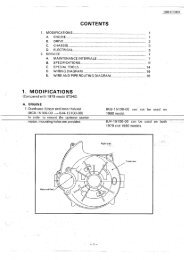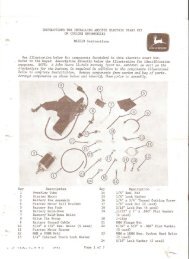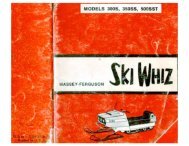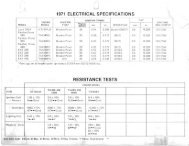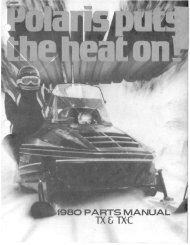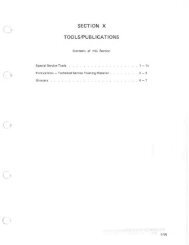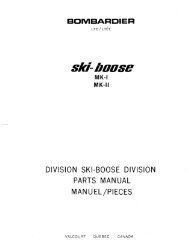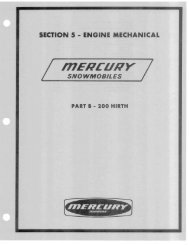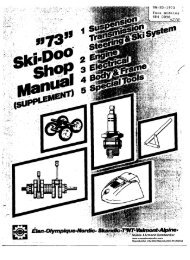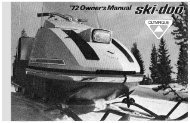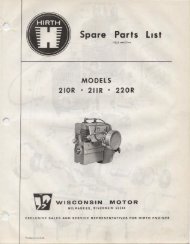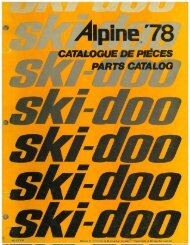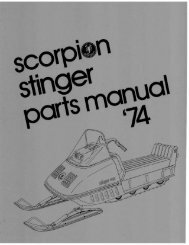1970 CCW 340 Service Manual - Vintage Snow
1970 CCW 340 Service Manual - Vintage Snow
1970 CCW 340 Service Manual - Vintage Snow
- No tags were found...
Create successful ePaper yourself
Turn your PDF publications into a flip-book with our unique Google optimized e-Paper software.
cserviceable condition, the condenser can be consideredserviceable. Inspect oil felt pads for cond it ion andsecurity; lubricate in accordance with Lubrication Chart,Table 2-2.d. Inspect all electrical connections for security; insulationfor chafing and deterioration.3.3.9 Flywheel Assemblya. Inspect cam, governor weight(s) and spring(s) for generalco nd iti on and security; cam for wear, particu Ia rly at pointof contact with governor weights.b. Check flywheel taper for snug fitting. When placed oncrankshaft hand tight, the flywheel should not wobble.c. Inspect magnets for nicks, scores or burrs. Use a suitab lestone to smooth off high spots.d. Inspect ring gear and teeth (if installed) for wear, generalcondition and security.e. Lubricate cam, governor weight and spring in accordancewith Lubrication Chart, Table 2-2.3.3.1 0 Cylinder Heads and Cylindersa. Inspect cylinder heads and cylinders for pitting, scoringand evidence of corros ion.b. Check cylinder heads for warp or distortion as follows:1. Place cylinder head, flat side down, on a surface plateor suitable measuring device.2. Using a feeler gauge, measure amount of distortion atpoint of contact between cylinder head and surfaceplate.Take a reading at each of the five I ocat ions betweencylinder head hold down studs.Maximum allowable distortion at any one location is0.002 inch.c. Check cylinders for distortion as follows:1. Install a serviceable head on cylinder to be checked.Do not install hold down nuts.2. Using a feeler gauge, measure amount of distortion atpoint of contact between cylinder head and cylinder.Take a reading at each of the five locations betweencylinder head hold down studs.Maximum allowable distortion at any one location is0.002 inch.d. Using a dial indicator or suitable measuring device, checkinside diameter of cylinders. Cylinders, worn beyondstandard tolerances, may be rebored to accomodate theinstal lation of oversize pistons. Refer to Table 3-1 forstandard and oversize fits and tolerances. The oversizeslisted in the table are the maximum allowable. Discardcylinders that requ ire boring in excess of tolerance shown.Replace with serviceab le cylinders.NOTE: Rebored cylinders should be honed with a finefinishing stone.3.3.11 Pistons, Pins and Ringsa. Inspect pistons, pins and rings for scoring and wear; pistoncrowns for pitting, evidence of corrosion and distortion.b. Check diameter of pistons, pins and pin bore; piston ringend and side clearances. Refer to Table 3-1 for method ofinspection and tolerances.c. Discard any parts that fail to meet applicable specificationsand note the following:1. If cylinder has been inspected and found serviceab le,replace defective piston with new standard size piston.3-92. If cyl inder has been rebored and hor)ed, replacedefective piston with oversize piston as listed in Table3-1.3.3.12 Crankshaft and Connecting Rodsa. Inspect threads on each end of shaft. The mating nut onthe flywheel end of the shaft should turn on all the way byhand without excessive looseness.Use a suitable thread cleaning tool to remove burrs fromthe threads. Replace worn nuts.b. Check tapered surface of flywheel end of shaft for scoringand wear. When placed on the shaft hand t ight, theflywheel should not wobble.c. Inspect keyway and Woodruff key for damage and wear.Replace worn keys.d. Inspect ball bearings for wea r, free movement andsecurity.e. Using Vee blocks (2) on a flat surface, support thecrankshaft on the center main bearings. Mount dialindicators at junction of tapered and parallel sections ofthe shaft and rotate crankshaft by the connecting rods.Refer to Tab le 3-1 for tolerances.f. Check crankshaft for bend or twist on the crankshaftjournals. Use a dial indicator placed on the main bearingjournals. Zero the indicator. Rotate crankshaft one fullturn. Refer to Table 3-1 for tolerances.g. Check connecting rod diameter at small end; side andvertical clearance at large end. Refer to Table 3-1 formethod of inspection and tolerance.h. Check connecting rod twist as follows:1. Insert a bar, 100 mm long or any other convenientlength, into the connecting rod small end . Centralizethe rod using a depth gauge and lock in position.2. Support connecting rod horizontally. Using a dialindicator measure the maximum height at oppositeends of the bar when the rod is twisted to the right andto the left. Any variation indicates connecting rodtwist. RefertoTable3-1 for tolerance.1. Check connecting rod tilt as fo llows:1. Repeatsteph(l).2. Support connecting rod vertically. Using a dial testindicator, measure the amou nt of movement at ends ofbar when bar is tilted to the right and to the left. Thedifference between the two readings indicates theamount of tilt. Refer to Tab le 3-1 for toleran ce.3.3.13 Crankcasea. Inspect crankcase mating surfaces for deep scratches,scoring and pitting.b. Inspect bearing and oi l sea l retaining inserts for wear,scoring or conditions which could cause leaks.c. Inspect at tach i ng dowel pins for wear and security.d. Discard crankcase if normal repair procedures are notsufficient to correct defects.3.3.14 Fits and TolerancesTable 3-1 lists standard fits and tolerances to be checkedduring inspection of pistons, piston pins, cylinders andcrankshaft. It also lists allowab le oversizes of pistons andrings. If suggested method of inspection is not avail ab le, usesuitable measuring devices.j



